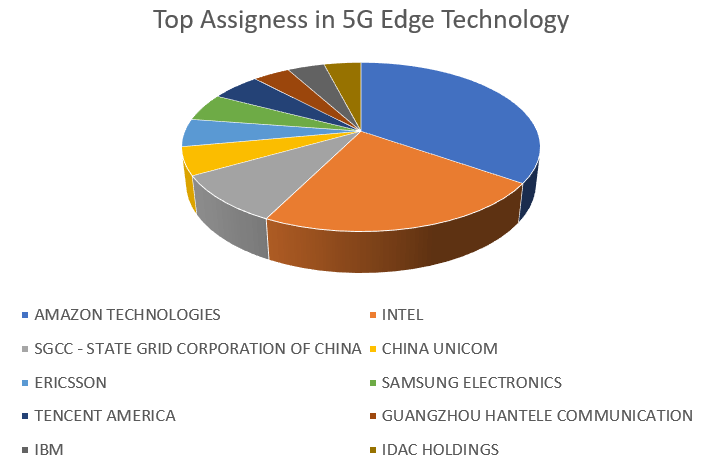Patent Trends in 5G Edge Computing Innovation: Assignees & Market Growth
5G Edge technology has revolutionized wireless communication by enhancing data security, efficiency and minimizing latency. As a result, numerous industries heavily reliant on real-time communication and high-speed data transfer are experiencing transformative benefits. The rapid adoption of 5G Edge technology has intensified the importance of protecting intellectual property (IP) rights associated with these innovations. Companies recognize the need to safeguard their 5G Edge computing innovation and are actively filing patents to secure their competitive advantage in this growing field. This escalating interest is evident in the increasing number of patent applications related to 5G Edge technology in recent years.
This article delves into 5G Edge technology, Telco Cloud, Network Function Virtualization, and 5G Edge computing market expansion. It also highlights pertinent patent filing trends, leading patent assignees, jurisdictions coverage, and the potential outlook for the advancing 5G Edge computing innovation.
Table of Contents
Overview of 5G Technology
5G is a fifth-generation wireless network standard that aims to connect everyone, including humans and machines, virtually. The main draw of 5G is its ability to provide communication with extremely low latency and offers more reliability with its vast network capacity. The wide range of cutting-edge features of 5G enables one to use their smartphone more parallel to the laptop. With it, people can enjoy intriguing features such as expanded multimedia options and online gaming.
The 5G Telco Cloud supports these features and enables telecom companies to transform into digital service providers.
What is a 5G Telco Cloud?
It is a software-based telecom service that relies on a highly resilient cloud. It allows telecom companies to add services quickly and rapidly change on demand while centrally managing their resources more efficiently. Telco Cloud is one of the key components for converting a telecommunications company into a digital service provider. It initially applied virtualization concepts from the data center into the network, which evolved to incorporate newer technologies such as containers, microservices, and hybrid cloud architectures in the 5G era. Containers and microservices must coexist with older virtualized network functions (VNFs), such as EPC, SD-WAN, and security technologies, as they are deployed into Telco Clouds.
The following section will delve into Network Function Virtualization (NFV), an essential component of the 5G Edge technology infrastructure.
Network Function Virtualization – An Introduction
Network Function Virtualization & Software-Defined Networking (SDN) reduced costs in early Telco Clouds by “lifting and shifting” appliance-based network elements (such as routers, firewalls, and load balancers) to software-based equivalents. Services were packaged as virtual machines (VMs) on commodity hardware, allowing service providers to run their networks without the expense of proprietary hardware. However, the NFV infrastructure often ran in vertically integrated stacks, providing the simplicity of working and resolving problems with a single vendor. However, this approach can be restrictive, similar to proprietary appliances, and may limit operators to a specific vendor’s agenda and roadmaps. Telcos and cloud service providers deployed several virtual network functions but, over time, found that VNFs delivered in vertically integrated stacks alone did not deliver the expected benefits of agility and lower costs.
Understanding Edge Computing and Multi-Access Edge Computing (MEC)
With the increasing need for real-time data processing and faster response times, Edge Computing and Multi-Access Edge Computing (MEC) have emerged as revolutionary technologies for computing innovation. These innovative approaches bring computing resources and data processing closer to the user, reducing latency and improving overall network performance.
- Edge Computing: It refers to the decentralization of computing resources and applications from the cloud to the edge of a network closer to the end-user. Edge Computing innovation aims to bring real-time data processing, decision-making, and faster response times to the network’s edge, reducing the latency and dependence on the cloud. Edge computing innovation also provides several benefits over cloud computing, including lower latency, reduced bandwidth costs, improved security, and increased privacy.
- Multi-Access Edge Computing: MEC moves traffic and service computing from a centralized cloud to the network’s edge and closer to the customer. Instead of sending all data to a cloud, the network edge analyses, processes, and stores it. High-bandwidth applications become more responsive when data is collected and processed closer to the customer.
While Edge Computing is a concept, MEC is the widely accepted architecture standard that technology must meet to be considered Edge Computing. While it is not an industry mandate for edge solutions to meet MEC standards, several vendors are building around them.
Leveraging Edge Computing
The report “5G for Business: A 2030 Market Compass” by Ericsson claims that Communication Service Providers (CSPs) may be able to capture a value of up to USD 700 billion of 5G-enabled business-to-business transactions by 2030.
5G and Edge Computing innovation have opened up opportunities for CSPs to provide new offerings to enterprises and other consumers. Enterprises seeking to automate industrial processes as well as consumers looking for enhanced user experiences in online gaming are approaching CSPs to leverage the benefits of 5G Edge computing innovations. Edge computing provides computing capabilities closer to the location of use, thereby targeting new business opportunities that provide support for specific application use cases. This technology has abundant scope for innovation in the upcoming future.
5G Edge Computing Innovations: A Move Towards a Better Future
Edge computing and 5G work well together and pave the way for a better digital future. Instead of being stored on a centralized cloud server, edge computing makes data locally accessible at an edge closer to the user, reducing latency issues. The data syncs continuously between remote data centers and edge locations. 5G is a cellular standard built from the core principles of 4G. In terms of data rate, latency, coverage, and availability, 5G offers substantial improvements over 4G. Businesses can significantly increase the accuracy and reliability of their data by combining edge computing’s performance with 5G’s speed. Automation orchestration across robots, machines, and different systems will improve thanks to the integration of 5G and edge computing innovation. In order to achieve ultra-low latency, a combination of 5G and edge computing is required for cases such as autonomous drones or remote telesurgery. Some of the application for 5G Edge includes:
- AI-based Video Surveillance
Live HD video is a highly effective site security and automation tool, and integrating it with artificial intelligence (AI) further enhances its value. In a 5G Edge setting, AI can analyze live video feeds in real-time to generate alerts, produce valuable insights, and record events such as shoplifting, ultimately leading to customer checkout-free shopping experiences.
- Patient Monitoring
Edge computing on the hospital site can process data locally, thereby ensuring that data privacy is maintained. It can further provide real-time notifications to medical practitioners about their patients’ condition (through analytics/AI) and can also create 360-degree view patient dashboards for full visibility.
- Smart Homes
The implementation of Edge Computing innovation allows processing and storing data closer to the smart home; thus, decreasing latency. This proximity also facilitates the local processing of sensitive data at the edge, enabling smart devices to respond more quickly.
Global 5G Edge Technology Market Overview
The global 5G Edge cloud network and services market, driven by computing innovation, is expected to generate substantial revenue and grow at a remarkable pace till 2030. The rising need for the management of mobile devices and applications to provide seamless connectivity to global geographies is driving this market growth.
5G Edge Patent Filing Trends by Assignees
To understand the intellectual property aspect of this technology, Sagacious IP performed a broad-level study of the companies that have patent filings in this domain. The study revealed that a large number of tech giants have been filing patents for their 5G Edge Computing innovation. It indicates the intense competition in the industry and the significant investment companies are making to secure a competitive edge.
Top Assignees

Amazon is a major player in the 5G Edge technology and computing innovation, accounting for 13.82% of the patents filed in this domain. Intel stands as the second-largest contributor, responsible for 9.04% of the patents filed. SGCC (State Grid Corporation of China) is another notable player, which accounts for 3.72% of the patents filed. Additionally, China Unicom, Ericsson, Samsung, and Tencent America each contribute 2.12% of the patents filed, demonstrating the diverse range of companies investing in this transformative technology. Furthermore, Guangzhou Hantele Communication, IBM, and IDAC Holdings each contribute 1.59% of the patents filed.

It comes as no surprise that companies such as Amazon, Intel, IBM, Samsung, and Ericsson lead the list of top 5G Edge patent assignees around the globe.
Patent Publishing Trends

As evident from Figure 3 above, 5G Edge patent publishing has been growing rapidly since 2017, reaching its peak at 154 in 2020.
Patent Coverage and Jurisdiction

5G Edge Technology is expanding rapidly in the United States, followed by China, WIPO, Europe, and India.
Conclusion
Conclusion
When compared to 4G, 5G can transmit data at a pace that is up to ten times faster. Edge computing innovation reduces latency by bringing computing capabilities closer to the end user. 5G Edge in cloud computing is a promising new technology that combines the power of 5G networks with the scalability and flexibility of cloud computing. The technology offers organizations low latency, scalability, and improved network performance, making it an attractive solution for various industries. As 5G networks continue to roll out, the market for 5G Edge in Cloud will likely grow rapidly, providing a range of opportunities for organizations to take advantage of this new technology.
Sagacious IP’s technology scouting service can help businesses build a strong patent portfolio of 5G Edge computing and cloud computing innovation. It is an effective tool for technological forecasting and, more generally, an element of business foresight. For additional information about our proficiency, please visit our technology scouting service page.
– Aashika Mittal, Shilpi Saxena (ICT Licensing), and the Editorial team
Having Queries? Contact Us Now!
"*" indicates required fields




